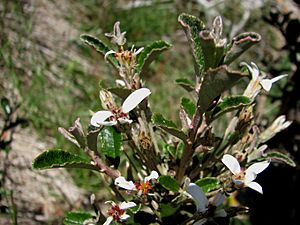Silky Daisy-bush facts for kids
Quick facts for kids Silky Daisy-bush |
|
|---|---|
 |
|
| Olearia myrsinoides Alpine National Park, Victoria |
|
| Scientific classification | |
| Kingdom: | |
| (unranked): | |
| (unranked): | |
| (unranked): | |
| Order: | |
| Family: | |
| Tribe: |
Astereae
|
| Genus: |
Olearia
|
| Species: |
O. myrsinoides
|
| Binomial name | |
| Olearia myrsinoides |
|
| Synonyms | |
|
Aster myrsinoides Labill. |
|
The Olearia myrsinoides, also known as the Silky Daisy-bush, is a type of flowering plant. It belongs to the Asteraceae family, which includes daisies and sunflowers. This plant grows as a shrub and can reach up to 1.5 metres (about 5 feet) tall.
The Silky Daisy-bush has special leaves and flowers. Its leaves are dark green on top and feel fuzzy underneath. The flowers look like small daisies. They have white "petals" (called ray florets) and a center with pale yellow or purple "mini-flowers" (called disc florets). These flowers usually appear from November to March in Australia.
Contents
About the Silky Daisy-bush
The Silky Daisy-bush is a native plant found in southeastern Australia. It is known for its pretty, daisy-like flowers and its soft, fuzzy leaves. This plant is an important part of the natural environment where it grows.
What the Silky Daisy-bush Looks Like
The Silky Daisy-bush is a medium-sized shrub. It can grow as tall as a person, up to 1.5 meters high.
Leaves and Stems
The leaves of the Silky Daisy-bush are quite interesting. They have small "teeth" along their edges. The top side of the leaves is a dark green color. But if you look underneath, they are covered in soft, white hairs. This fuzzy texture is why it's called "Silky."
Flowers and Blooms
The flowers of the Silky Daisy-bush are its most striking feature. Each flower head looks like a small daisy. They have two to four white "petals" around the outside. These are called ray florets. In the middle of the flower, there are three to four tiny flowers. These are called disc florets and can be pale yellow or a light purple color. You can see these beautiful flowers blooming from late spring through summer.
Where the Silky Daisy-bush Grows
The Silky Daisy-bush is found in several parts of Australia. It grows naturally in New South Wales, Victoria, and Tasmania.
Natural Habitats
This plant likes to grow in different kinds of places. You can find it in woodland areas, open grasslands, and even in swampy spots. It prefers areas where the ground might be a bit wet. In New South Wales, it grows in the southern parts, below the McPherson Range.
How the Silky Daisy-bush Got its Name
The scientific name for the Silky Daisy-bush is Olearia myrsinoides. Plants often get their names from the people who first described them or from their features.
Early Discoveries
A French scientist named Jacques Labillardière first described this plant. He wrote about it in 1806 in his book Novae Hollandiae Plantarum Specimen. At that time, he gave it the name Aster myrsinoides.
Changing Names
Later, in 1867, the plant's name was changed. It was moved into the group (or genus) called Olearia. This change happened in a book called Flora Australiensis. This is why its full scientific name today is Olearia myrsinoides.

